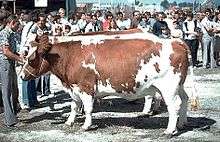Pie Rouge des Plaines
The Pie Rouge des Plaines is a modern French breed of dairy cattle.[2] It was created in about 1970 by cross-breeding the traditional Armorican cattle of Brittany, in north-western France, with red-pied cattle of the Dutch Meuse-Rhine-Yssel and German Deutsche Rotbunte breeds.
 | |
| Country of origin | France |
|---|---|
| Distribution | |
| Use | dual-purpose, milk and meat |
| Traits | |
| Weight | |
| Height | |
| Skin colour | beige |
| Coat | red-pied |
| Horn status | horned in both sexes |
| |
History
The Pie Rouge des Plaines is a modern breed. In 1970, farmers raising the traditional red-pied Armorican cattle in the three western départements of Brittany – Côtes-d'Armor, Finistère and the Morbihan – took the decision to merge their breed with red-pied cattle of Germany and the Netherlands, through a programme of extensive cross-breeding with German Rotbunt and Dutch Meuse-Rhine-Yssel stock, to create a new dairy breed with good meat-producing qualities.[1]:72[3]:179 A breeders' association, the Eleveurs de la Race Française Pie Rouge des Plaines, was formed, and a herd-book was opened for the new breed in 1970 [4] or 1971.[1]:72 From 1982 an attempt was made to increase size and udder quality by introducing Red Holstein blood; however, the resulting stock was less successful for beef production.[1]:72
The Pie Rouge des Plaines is concentrated mainly in Brittany, where about 80% of the total herd is found; it is also distributed in Normandy, and – to a lesser extent – in the Massif Central.[1]:73 The total population is estimated at about 60 000, with approximately 3 500 cows registered in the herd-book.[5] Frozen semen from some 150 bulls is available for artificial insemination.[5]
The original Armorican breed has become rare: it was listed by the FAO as "critically endangered" in 2007.[6]:136 In 2005, the population was estimated at about 240 head,[7] and in 2014 it was 263.[8]
Characteristics
The Pie Rouge des Plaines is red-pied, with short crescent-shaped horns. The skin, muzzle and mucosa are pale. Cows have good resistance to mastitis.[1]:75
Use
Pie Rouge des Plaines has good dairy aptitude. Milk yield is of the order of 8000 kg in a lactation of 329 days. The milk has 4.3% fat and 3.3% protein. Meat production also contributes to profitability.[1]:75
References
- Marie Dervillé, Stéphane Patin, Laurent Avon (2009). Races bovines de France: origine, standard, sélection (in French). Paris: Éditions France Agricole. ISBN 9782855571515.
- EAAP Animal genetic data bank
- Valerie Porter, Lawrence Alderson, Stephen J.G. Hall, D. Phillip Sponenberg (2016). Mason's World Encyclopedia of Livestock Breeds and Breeding (sixth edition). Wallingford: CABI. ISBN 9781780647944.
- Breed data sheet: Pie Rouge des Plaines/France. Domestic Animal Diversity Information System of the Food and Agriculture Organization of the United Nations. Accessed January 2017.
- Étude de la race bovine: Pie Rouge des Plaines (in French). Bureau des Ressources Génétiques. Archived 17 May 2015.
- Barbara Rischkowsky, D. Pilling (eds.) (2007). List of breeds documented in the Global Databank for Animal Genetic Resources, annex to The State of the World's Animal Genetic Resources for Food and Agriculture. Rome: Food and Agriculture Organization of the United Nations. ISBN 9789251057629. Accessed January 2017.
- Étude de la race bovine: Armoricaine (in French). Bureau des Ressources Génétiques. Archived 17 May 2015.
- Breed data sheet: Armoricaine/France. Domestic Animal Diversity Information System of the Food and Agriculture Organization of the United Nations. Accessed November 2016.